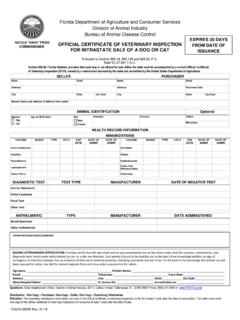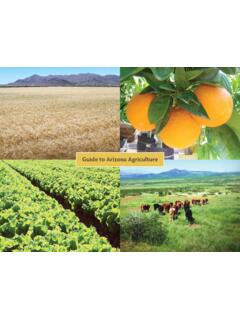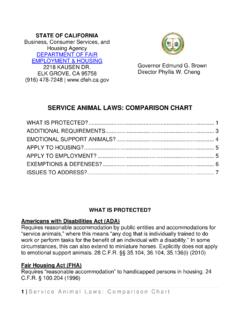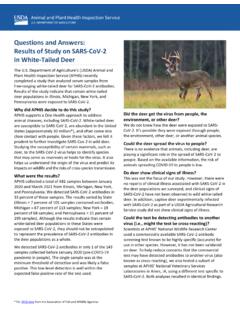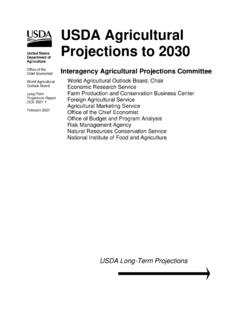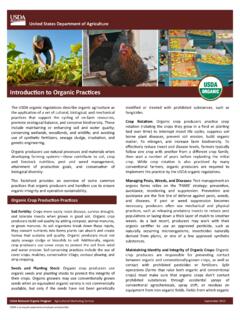Transcription of Solar photovoltaics for sustainable agriculture and rural ...
1 Solar photovoltaics for sustainable agriculture and rural development by B. van Campen, D. Guidi and G. Best 76 pp., 21 tables, 10 text boxes, 6 annexes Environment and Natural Resources Working Paper No. 2. FAO, Rome, 2000. Abstract Solar photovoltaic (PV) systems have shown their potential in rural electrification projects around the world, especially concerning Solar Home Systems. With continuing price decreases of PV systems, other applications are becoming economically attractive and growing experience is gained with the use of PV in such areas as social and communal services, agriculture and other productive activities, which can have a significant impact on rural development.
2 There is still a lack of information, however, on the potential and limitations of such PV applications. The main aim of this study is, therefore, to contribute to a better understanding of the potential impact and of the limitations of PV systems on sustainable agriculture and rural development (SARD), especially concerning income-generating activities. It is, in fact, of paramount importance to identify the potential contribution of PV to rural development in order to gain further financial and political commitment for PV projects and programmes and to design appropriate PV projects.
3 One of the main lessons learnt through this study is that success of PV programmes is significantly enhanced when an integrated strategy is followed. Solar photovoltaic systems, through their flexibility in use, offer unique chances for the energy sector to provide packages of energy services to remote rural areas such as for rural health care, education, communication, agriculture , lighting and water supply. It is hoped that this document contributes to the generation of ideas and discussions among the different institutions involved in providing these services to rural areas and thereby to an "informed" decision on the PV technology option.
4 Keywords: Solar energy; photovoltaic; rural development; income generation; agriculture ;. aquaculture; livestock This series replaces the following: * Environment and Energy Series * Remote Sensing Centre Series * Agrometeorology Working Papers List of documents published in the above series and other information can be found at our website: http:// iii Cover photo: Solar photovoltaic panel for the operation of a water pump to pump water from the river in the background into the multi-purpose garden. This system is part of an FAO project focused on forest and village territory management near the Senegal River, in the northern region of Senegal (Dagana and Podor).
5 The project provides organizational and technical training. The multi-purpose gardens have become rather popular in villages of those departments. The villagers, particularly groups of women and young men, lay out a garden, around which they plant trees for protection against the wind and the sun. All kinds of horticultural products that can improve local living conditions are grown in these plots, usually situated on the edge of the village. The characteristics of each garden depend on the local situation and the imagination of the persons in charge.
6 Some even have beehives. A course on agrarian studies has been included in the school curriculum in Podor to explain the multi-purpose gardens in the village. Author: I. Balderi, 1995. iv Foreword Energy is an important input for the provision of basic human needs and services, such as cooking, water supply, lighting, health services, communication and education. It is also an essential input for the enhancement of rural production and food security, through land preparation, fertilization, irrigation, agro-processing, conservation and transport.
7 In many rural areas of developing countries, energy needs are, at present, predominantly supplied in the form of traditional biomass fuels, human and animal labour. This inequitable scenario severely limits many rural people from enhancing their agricultural productivity and quality of life. The Food and agriculture Organization of the United Nations continues to promote the achievement of sustainable agriculture and rural development (SARD) as task manager of Chapter 14 of Agenda 21. The present study aims to contribute to this process by assisting the Organization's member countries in their transition to more sustainable rural energy systems.
8 FAO recognizes the Solar photovoltaic (PV) system as a technology that is already providing energy services in many sites around the world, mainly at the household level, and draws attention to its potential in fostering new income-generating activities and higher agricultural productivity. One of the main lessons learnt through this study is that the success of PV programmes is significantly enhanced when an integrated strategy is followed. Solar photovoltaic systems, through their flexibility, offer unique opportunities for the energy sector to provide packages of energy services to remote rural areas, for example, for health care, education, communication, agriculture , lighting and water supply.
9 It is hoped that this document will contribute to the generation of ideas and discussions between the different institutions involved in providing these services to rural areas and thereby to an "informed" decision on the PV technology option. The authors are greatly indebted to all who assisted in the completion of this study and its final report. A range of people from development agencies, industry, NGOs, universities and colleagues from FAO contributed significantly with ideas, data, experience and critical comments. Special thanks go to all those who responded to the survey launched in preparation for the study.
10 The authors are particularly grateful to Ms Cecelski and Mr Sinha for their fundamental and constructive comments. FAO hopes that this study will contribute, even in a small way, to a much-needed change in the energy scenario of rural areas in developing countries and, in particular, to the integration of PV systems in agriculture and to the integration of agriculture into ongoing PV. programmes. Jacques Eckebil Officer-in-Charge sustainable Development Department v Abbreviations and Acronyms AC Alternating Current BCS Battery Charging Station CDM Clean Development Mechanism CFL, FL Compact Fluorescent Light or Fluorescent Light.











